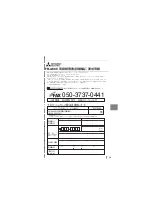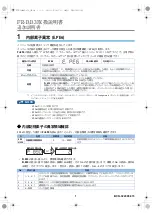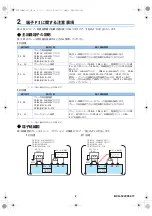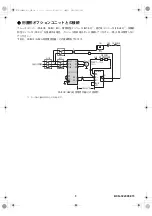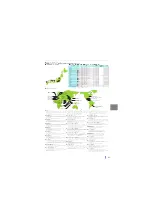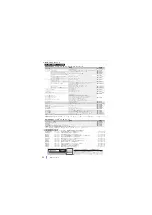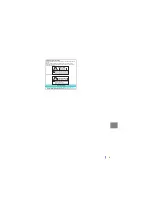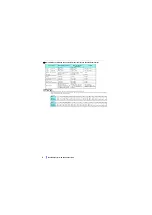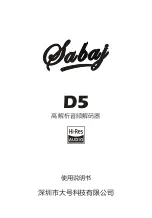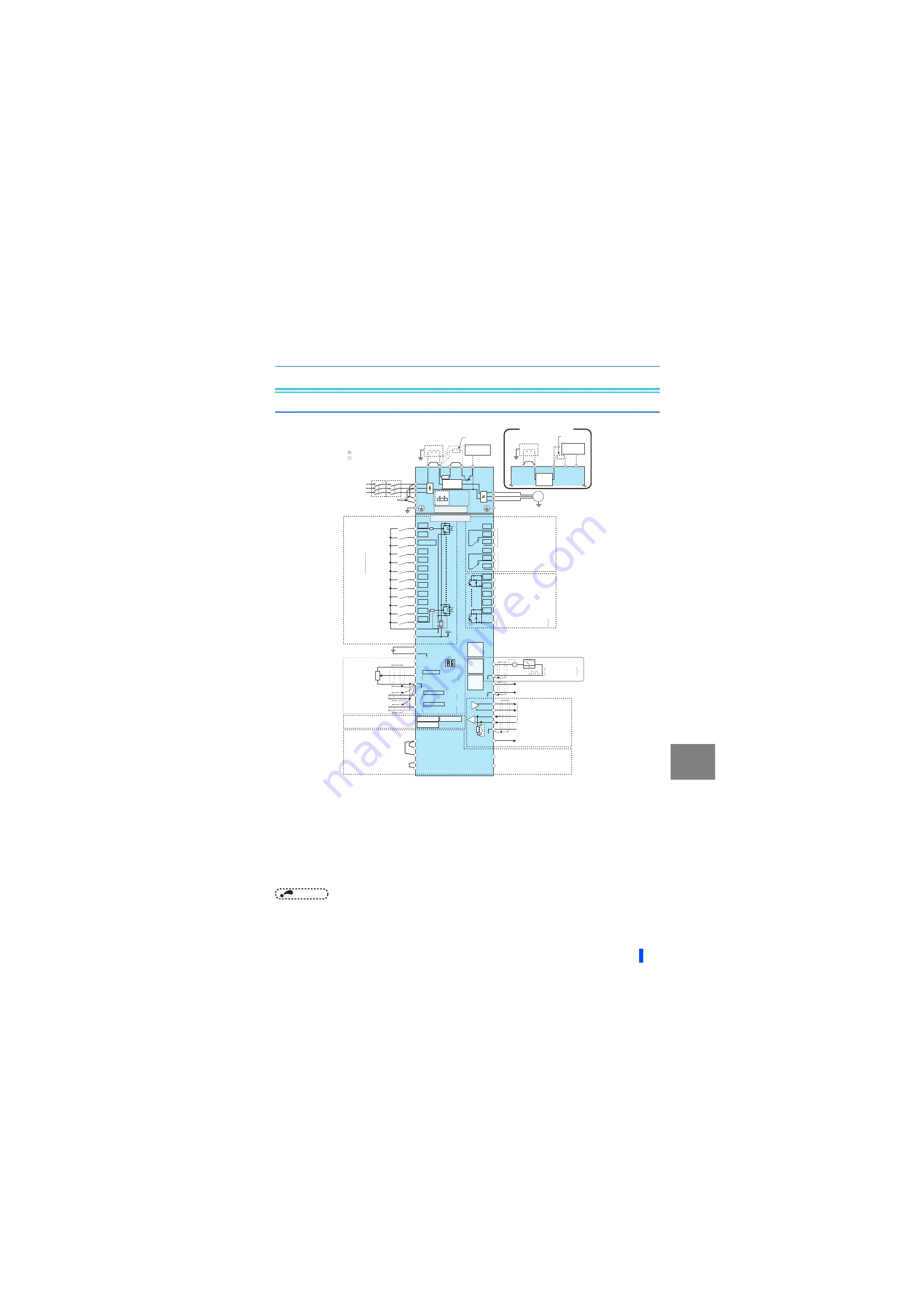
Terminal connection diagrams
7
2
WIRING
2.1
Terminal connection diagrams
For the 75K or higher, always connect a DC reactor (FR-HEL), which is available as an option. (To select a DC reactor, refer to
, and select one according to the
applicable motor capacity.)
When connecting a DC reactor, if a jumper is installed across terminals P1 and P/+, remove the jumper before installing the DC reactor. (The jumper is not installed for
the FR-B-75K or higher.)
When using separate power supply for the control circuit, remove the jumper between R1/L11 and S1/L21.
The function of these terminals can be changed with the input terminal assignment
(Pr.178 to Pr.189)
Terminal JOG is also used as the pulse train input terminal. Use
Pr.291
to choose JOG or pulse.
Terminal input specifications can be changed by analog input specification switchover
(Pr.73, Pr.267)
. To input a voltage, set the voltage/current input switch OFF. To
input a current, set the voltage/current input switch ON. Terminals 10 and 2 are also used as a PTC input terminal.
(Pr.561)
(Refer to the FR-A800 Instruction Manual
(Detailed).)
It is recommended to use 2 W 1 k
Ω
when the frequency setting signal is changed frequently.
If connecting a brake resistor, remove the jumper between PR and PX (FR-B-750 to 7.5K, FR-B3-(N)(H)400 to 7.5K).
Connect a brake resistor across terminals P/+ (P3) and PR. (Terminal PR is equipped in FR-B-750 to 22K (200 V class), FR-B-750 to 55K (400 V class), FR-B3-(N)400
to 22K, FR-B3-(N)H400 to 37K.) Install a thermal relay to prevent overheating and damage of discharging resistors. (Refer to the FR-A800 Instruction Manual
(Detailed).)
The function of these terminals can be changed with the output terminal assignment
(Pr.195, Pr.196)
. (Refer to
The function of these terminals can be changed with the output terminal assignment
(Pr.190 to Pr.194)
. (Refer to
.)
The terminal F/C (FM) can be used to output pulse trains as open collector output by setting
Pr.291
.
Not required when calibrating the scale with the operation panel.
Do not remove the shorting wires across the terminals S1 and PC, the terminals S2 and PC, and the terminals SIC and SD. Removing any shorting wire disables the
inverter operation.
NOTE
• It is mandatory to use the Mitsubishi Electric pressure-resistant, explosion-proof motor with the inverter which has been approved for combination by the Japanese
Ministry of Health, Labor and Welfare's explosion-proof certification. Therefore, always use the Mitsubishi Electric pressure-resistant, explosion-proof motor in
combination with its approved driving inverter.
• To prevent a malfunction due to noise, keep the signal cables 10 cm or more away from the power cables. Also, separate the main circuit cables at the input side from
the main circuit cables at the output side.
• After wiring, wire offcuts must not be left in the inverter. Wire offcuts can cause an alarm, failure or malfunction. Always keep the inverter clean. When drilling mounting
holes in an enclosure etc., take caution not to allow chips and other foreign matter to enter the inverter.
• Set the voltage/current input switch correctly. Incorrect setting may cause a fault, failure or malfunction.
Three-phase
AC power
supply
MCCB
R/L1
S/L2
T/L3
R1/L11
S1/L21
PC
24VDC power supply
(Common for external power supply transistor)
Forward rotation start
Reverse rotation start
Start self-holding selection
Middle speed
High speed
Low speed
Jog operation
Second function selection
Output stop
Reset
Terminal 4 input selection
(Current input selection)
Selection of automatic restart
after instantaneous
power failure
Frequency setting signals (Analog)
10E(+10V)
10(+5V)
2
(Analog common)
2
3
1
Auxiliary
input
Terminal 4 input
(Current input)
1
4
Frequency setting
potentiometer
1/2W1kΩ
∗6
Running
Up to frequency
Instantaneous
power failure
Overload
Frequency detection
Open collector output common
Sink/source
common
F/C
(FM)
SD
Control input signals
(No voltage input allowed)
∗3
Jumper
Explosion-proof motor
Relay output 1
(Fault output)
C1
B1
A1
U
V
W
P1
Indicator
(Frequency meter, etc.)
+
-
(-)
(+)
Analog signal output
(0 to ±10VDC)
Earth
(Ground)
AM
5
DC0 to ±5V selectable
DC0 to ±10V
Multi-speed
selection
Open collector output
∗10
Moving-coil type
1mA full-scale
Contact input common
Calibration
resistor
∗12
Earth
(Ground)
Main circuit terminal
Control circuit terminal
DC0 to 5V
DC0 to 10V selectable
MC
Main circuit
C2
B2
A2
Relay output 2
Relay output
∗9
M
DC0 to 20mA
DC0 to 5V
DC0 to 10V
selectable
DC4 to 20mA
TXD+
Terminating
resistor
TXD-
RXD+
RXD-
GND
(SG)
Data
transmission
GND
RS-485 terminals
PU
connector
USB A
connector
USB
mini B
connector
SINK
SOURCE
∗4
∗5
∗5
∗11
∗5
∗5
Connector for plug-in option connection
STF
STR
STP(STOP)
RH
RM
RL
JOG
RT
MRS
RES
AU
CS
SD
RUN
SU
IPF
OL
FU
SE
Data
reception
(+)
(-)
5
EMC filter
ON/OFF
connecter
ON
OFF
+24
24V external power
supply input
SD
Common terminal
VCC
(+)
(-)
5V
(Permissible load current 100mA)
Sink logic
∗2
Earth (Ground)
R
R
Connector 1 Connector 2
Connector 3
Jumper
Jumper
PX
PR
N/-
P/+
Control circuit
Initial value
Initial value
Initial value
ON
4
2
OFF
Voltage/current
input switch
Brake unit
(Option)
DC reactor
(FR-HEL)
∗1
Brake resistor
(FR-ABR)
∗7∗8
So (SO)
SOC
S1
S2
PC
SD
SIC
For manufacturer
∗13
Shorting
wire
Jumper
P1
Earth
(Ground)
R
P3
PR
N/-
P/+
Brake unit
(Option)
DC reactor
(FR-HEL)
∗1
Brake resistor
∗8
Inrush
current
limit circuit
FR-B-15K, 22K (200 V class
)
FR-B-15K to 55K (400 V class
)
FR-B3-(N)15K, 22K
FR-B3-(N)H15K to 37K
24V
Inrush current
limit circuit


